英语语法大攻克--介词用法
介词用法详细解析
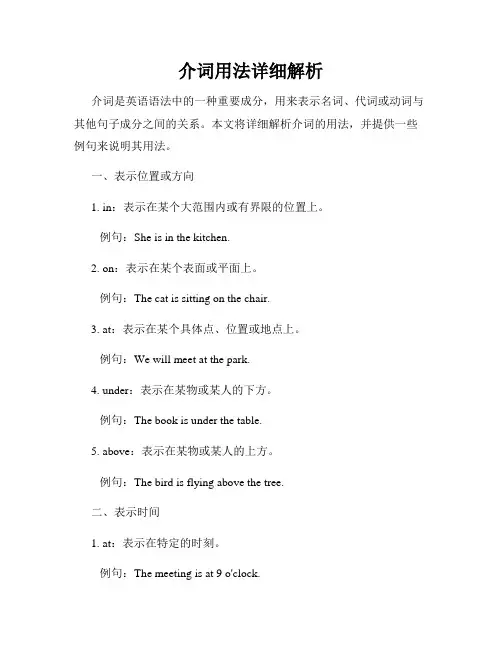
介词用法详细解析介词是英语语法中的一种重要成分,用来表示名词、代词或动词与其他句子成分之间的关系。
本文将详细解析介词的用法,并提供一些例句来说明其用法。
一、表示位置或方向1. in:表示在某个大范围内或有界限的位置上。
例句:She is in the kitchen.2. on:表示在某个表面或平面上。
例句:The cat is sitting on the chair.3. at:表示在某个具体点、位置或地点上。
例句:We will meet at the park.4. under:表示在某物或某人的下方。
例句:The book is under the table.5. above:表示在某物或某人的上方。
例句:The bird is flying above the tree.二、表示时间1. at:表示在特定的时刻。
例句:The meeting is at 9 o'clock.2. on:表示在某一天或某个具体日期。
例句:We have a party on Saturday.3. in:表示在某个时间段或某个月、季节、年份。
例句:She will visit us in summer.4. by:表示到某个时间点之前。
例句:Please finish the report by tomorrow.三、表示方式或原因1. by:表示通过某种方式或手段。
例句:She learned English by watching movies. 2. through:表示穿过或通过某个空间。
例句:The car drove through the tunnel.3. because of:表示由于某个原因。
例句:He couldn't come because of the rain.四、表示目的1. for:表示为了某个特定目的或用途。
例句:I bought this book for studying English.2. to:表示朝着某个目标或方向。
英语介词用法详解
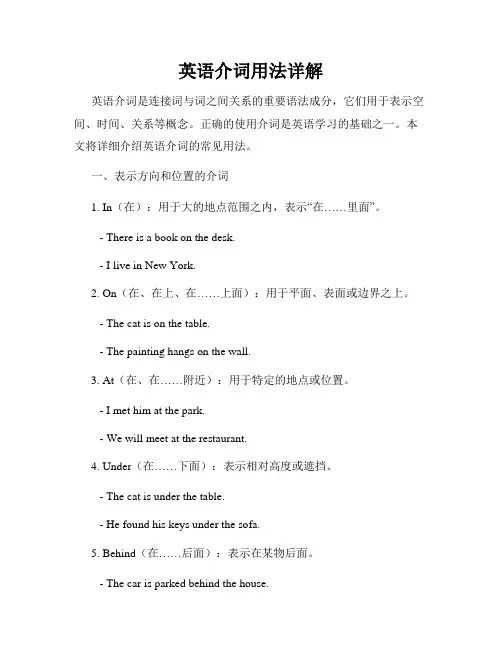
英语介词用法详解英语介词是连接词与词之间关系的重要语法成分,它们用于表示空间、时间、关系等概念。
正确的使用介词是英语学习的基础之一。
本文将详细介绍英语介词的常见用法。
一、表示方向和位置的介词1. In(在):用于大的地点范围之内,表示“在……里面”。
- There is a book on the desk.- I live in New York.2. On(在、在上、在……上面):用于平面、表面或边界之上。
- The cat is on the table.- The painting hangs on the wall.3. At(在、在……附近):用于特定的地点或位置。
- I met him at the park.- We will meet at the restaurant.4. Under(在……下面):表示相对高度或遮挡。
- The cat is under the table.- He found his keys under the sofa.5. Behind(在……后面):表示在某物后面。
- The car is parked behind the house.- She is hiding behind the tree.6. Beside(在……旁边):表示在某物的旁边。
- My house is beside the park.- She sat beside her friends.7. Inside(在……里面):表示在某物的内部。
- The wallet is inside the bag.- There is a surprise inside the box.8. Outside(在……外面):表示在某物的外部。
- The children are playing outside the house.- Don't forget to lock the door when you go outside.二、表示时间的介词1. On(在某天):用于特定的日期。
介词用法总结
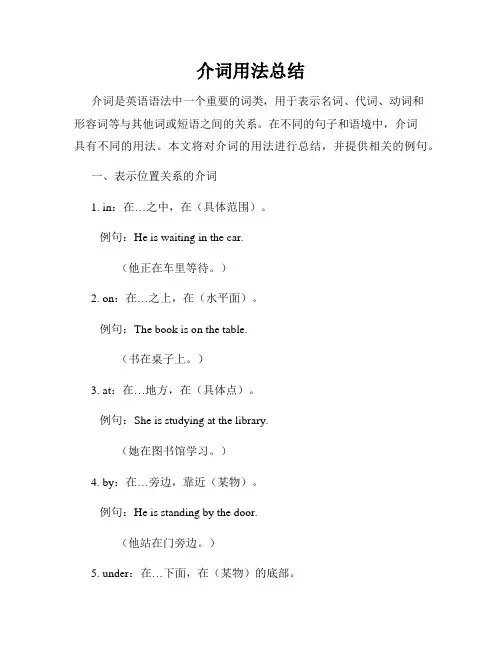
介词用法总结介词是英语语法中一个重要的词类,用于表示名词、代词、动词和形容词等与其他词或短语之间的关系。
在不同的句子和语境中,介词具有不同的用法。
本文将对介词的用法进行总结,并提供相关的例句。
一、表示位置关系的介词1. in:在…之中,在(具体范围)。
例句:He is waiting in the car.(他正在车里等待。
)2. on:在…之上,在(水平面)。
例句:The book is on the table.(书在桌子上。
)3. at:在…地方,在(具体点)。
例句:She is studying at the library.(她在图书馆学习。
)4. by:在…旁边,靠近(某物)。
例句:He is standing by the door.(他站在门旁边。
)5. under:在…下面,在(某物)的底部。
例句:The cat is hiding under the bed.(猫在床下躲藏。
)6. between:在…之间(两者之间)。
例句:The restaurant is located between the bank and the supermarket.(这家餐厅位于银行和超市之间。
)二、表示时间关系的介词1. at:在(具体时间点)。
例句:She will meet her friend at 8 o'clock.(她将在8点钟见她的朋友。
)2. on:在(具体日期或星期)。
例句:I have a meeting on Monday.(星期一我有个会议。
)3. in:在(一段时间内)。
例句:He will travel to Europe in summer.(他将在夏天去欧洲旅行。
)4. during:在…期间,表示全程。
例句:I read a book during the flight.(我在飞行途中读了一本书。
)5. for:持续时间,表示时间段。
例句:They have been married for ten years.(他们已经结婚十年了。
介词的常见用法及注意事项
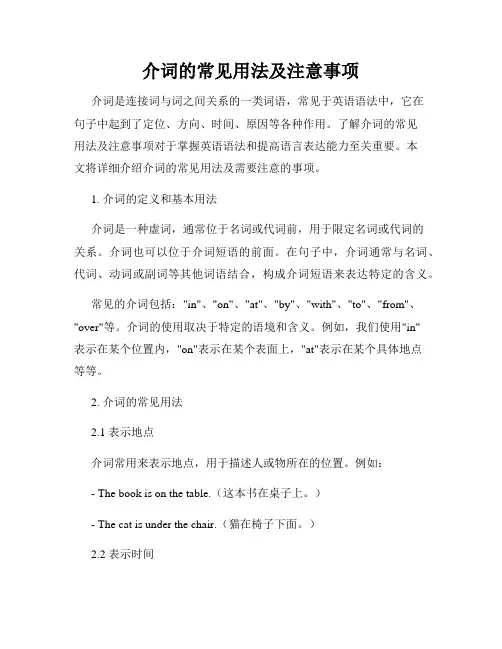
介词的常见用法及注意事项介词是连接词与词之间关系的一类词语,常见于英语语法中,它在句子中起到了定位、方向、时间、原因等各种作用。
了解介词的常见用法及注意事项对于掌握英语语法和提高语言表达能力至关重要。
本文将详细介绍介词的常见用法及需要注意的事项。
1. 介词的定义和基本用法介词是一种虚词,通常位于名词或代词前,用于限定名词或代词的关系。
介词也可以位于介词短语的前面。
在句子中,介词通常与名词、代词、动词或副词等其他词语结合,构成介词短语来表达特定的含义。
常见的介词包括:"in"、"on"、"at"、"by"、"with"、"to"、"from"、"over"等。
介词的使用取决于特定的语境和含义。
例如,我们使用"in"表示在某个位置内,"on"表示在某个表面上,"at"表示在某个具体地点等等。
2. 介词的常见用法2.1 表示地点介词常用来表示地点,用于描述人或物所在的位置。
例如:- The book is on the table.(这本书在桌子上。
)- The cat is under the chair.(猫在椅子下面。
)2.2 表示时间介词还常用来表示时间,用于描述事件发生的时间。
例如:- I will meet her at 8 o'clock.(我将在8点钟见她。
)- They usually have dinner on Sundays.(他们通常在星期天吃晚饭。
)2.3 表示方式或原因有些介词可以表示某个动作的方式或原因。
例如:- He broke the vase with a hammer.(他用锤子打碎了花瓶。
)- She cried because of the sad news.(她因为这个悲伤的消息而哭了。
介词的用法与搭配技巧让句子更简洁明了
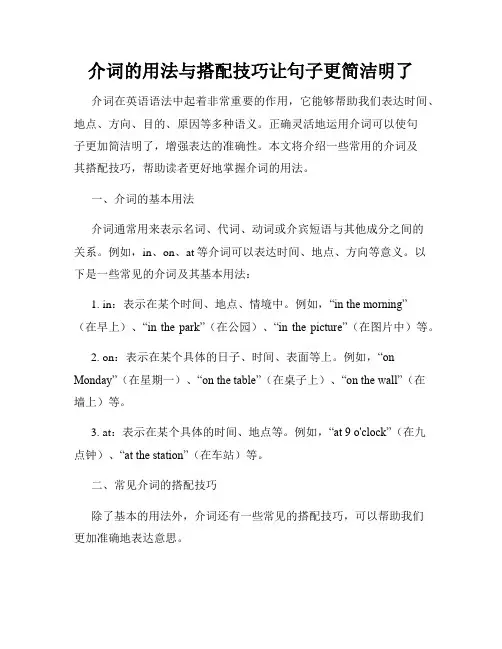
介词的用法与搭配技巧让句子更简洁明了介词在英语语法中起着非常重要的作用,它能够帮助我们表达时间、地点、方向、目的、原因等多种语义。
正确灵活地运用介词可以使句子更加简洁明了,增强表达的准确性。
本文将介绍一些常用的介词及其搭配技巧,帮助读者更好地掌握介词的用法。
一、介词的基本用法介词通常用来表示名词、代词、动词或介宾短语与其他成分之间的关系。
例如,in、on、at等介词可以表达时间、地点、方向等意义。
以下是一些常见的介词及其基本用法:1. in:表示在某个时间、地点、情境中。
例如,“in the morning”(在早上)、“in the park”(在公园)、“in the picture”(在图片中)等。
2. on:表示在某个具体的日子、时间、表面等上。
例如,“on Monday”(在星期一)、“on the table”(在桌子上)、“on the wall”(在墙上)等。
3. at:表示在某个具体的时间、地点等。
例如,“at 9 o'clock”(在九点钟)、“at the station”(在车站)等。
二、常见介词的搭配技巧除了基本的用法外,介词还有一些常见的搭配技巧,可以帮助我们更加准确地表达意思。
1. 表示位置关系:介词常用来表示物体或人在空间中的位置关系。
例如,“in front of”(在...前面)、“behind”(在...后面)、“next to”(在...旁边)、“above”(在...上面)、“under”(在...下面)等。
2. 表示原因与结果:介词也可以用来表示原因与结果的关系。
例如,“because of”(因为)、“due to”(由于)、“result from”(由...引起)等。
3. 表示方式与手段:介词可以表示某种方式或手段。
例如,“by”(通过)、“with”(用)等。
例如,“by email”(通过电子邮件)、“with a knife”(用刀)等。
英语语法大攻克--介词+形容词的用法
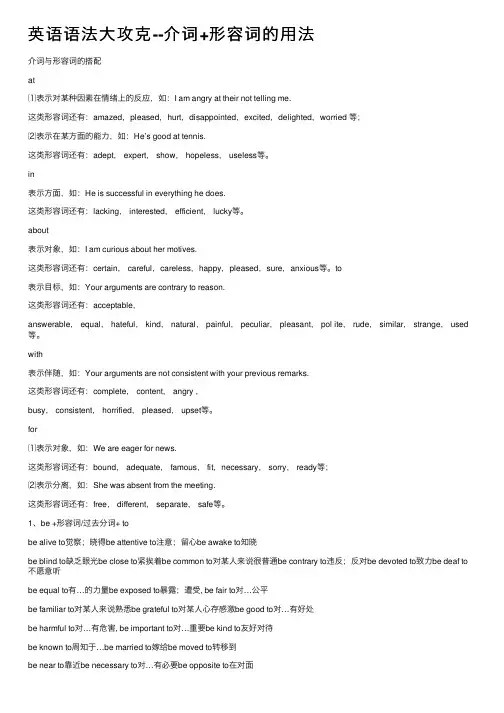
英语语法⼤攻克--介词+形容词的⽤法介词与形容词的搭配at⑴表⽰对某种因素在情绪上的反应,如:I am angry at their not telling me.这类形容词还有:amazed,pleased,hurt,disappointed,excited,delighted,worried 等;⑵表⽰在某⽅⾯的能⼒,如:He’s good at tennis.这类形容词还有:adept, expert, show, hopeless, useless等。
in表⽰⽅⾯,如:He is successful in everything he does.这类形容词还有:lacking, interested, efficient, lucky等。
about表⽰对象,如:I am curious about her motives.这类形容词还有:certain, careful,careless,happy,pleased,sure,anxious等。
to表⽰⽬标,如:Your arguments are contrary to reason.这类形容词还有:acceptable,answerable, equal, hateful, kind, natural, painful, peculiar, pleasant, pol ite, rude, similar, strange, used 等。
with表⽰伴随,如:Your arguments are not consistent with your previous remarks.这类形容词还有:complete, content, angry ,busy, consistent, horrified, pleased, upset等。
for⑴表⽰对象,如:We are eager for news.这类形容词还有:bound, adequate, famous, fit,necessary, sorry, ready等;⑵表⽰分离,如:She was absent from the meeting.这类形容词还有:free, different, separate, safe等。
介词的基本用法
介词的基本用法介词是语法中的一种词类,用来表示名词、代词等与其他词之间的关系。
介词通常位于名词短语前面,起到连接词语的作用。
本文将详细介绍介词的基本用法。
1. 表示地点关系介词常用于表示物体或人的位置关系,可以简明地描述地点。
例如:in(在)、on(在…上面)、at(在…旁边)、under(在…下面)等。
示例:The book is on the table.(书在桌子上。
)2. 表示时间关系介词还可以用于表示时间关系,精确描述某个事件发生的时间或持续的时间。
常用的表示时间关系的介词有:at(在某个具体时刻)、on(在某天或某个具体日期)、in(在某个时间段内)等。
示例:I will meet him at 9 o'clock.(我将在9点钟见他。
)3. 表示原因关系有些介词可以表示原因、理由或出发点,常用的有:for(为了)、because of(因为)、due to(由于)等。
示例:He went to the park because of the nice weather.(他因为天气好去了公园。
)4. 表示方式和手段介词也可以表示某个行动或状态发生的方式或手段。
例如:by(凭借、通过)、with(用、带着)等。
示例:She draws a picture with a pencil.(她用铅笔画了一幅图画。
)5. 表示目的和结果有些介词可用于表示某个行动的目的或结果,如:to(表示目的)、for(表示目的)、result in(导致)等。
示例:I am going to the supermarket to buy some groceries.(我去超市买些日用品。
)6. 表示比较和对比介词还可以用于表示比较和对比关系。
例如:than(比)、as(和…一样)、like(像)等。
示例:She is taller than her sister.(她比她妹妹高。
)总结:介词在语法中起到连接词语的作用,表示名词、代词等与其他词之间的关系。
英语语法大攻克--介词 some any have has用法
语法训练四:介词、some与any、have与has一、介词复习(表示方位词的基本知识)in:“在……里面”;in the bedroom;in the house;on:“在……上面”;on the table,on the wallunder:“在……之下”;under the bed,under the treein front of :“在……前面”;in front of the housebeside:“在……旁边”;beside the deskbehind:“在……后面”;behind the dooragainst:“依靠”;against the wall,against the door练习:介词in/on/under/beside填空。
(1)Let’s watch TV the living room.(2)Sit the sofa.(3)The cookies are the table the kitchen.(4)The glasses are the cupboard.(5)The cookies are the fridge.(6)The computer is the study.(7)Put the chairs the desks,please.(8)The board rubber is (在……后面)the exercise books.(9)The tape recorder is that corner.(10)Put the tape recorder the shelf.二、some和any1)some“几个,一些”;可修饰可数名词和不可数名词,主要用于肯定句。
例:There are some books on the table. (肯定句,book是可数名词) There is some milk in the bottle. (肯定句,milk是不可数名词)2)any“几个,一些”;可修饰可数名词和不可数名词,但any常用于否定句和疑问句。
介词的用法总结
介词的用法总结一、介词的定义介词是连接代词、名词、动词,构成介词短语的虚词。
它用以引导名词或代词等其他成分,表示它们与其他成分之间的关系。
二、介词的分类1.空间介词:表示地点或方向如:at, in, on, under, over, above, below, beside, behind, in front of 等。
示例:The cat is on the table.(猫在桌子上。
)2.时间介词:表示时间如:at, on, in, for, during, since, before, after等。
示例:I usually get up at six in the morning.(我通常早上六点钟起床。
)3.方式介词:表示方式或手段如:with, by, like等。
示例:She cut the cake with a knife.(她用刀切蛋糕。
)4.目的介词:表示目的或原因如:for, to等。
示例:He went to the park for a walk.(他去公园散步。
)5.比较介词:表示比较关系如:like, than等。
示例:I like apples more than bananas.(我比较喜欢苹果而不是香蕉。
)6.从属连词后的介词:如after, before, since等,表示时间如:before dinner, after class等。
示例:I usually go to the gym after work.(我通常下班后去健身房。
)7.词组中的固定搭配,如be fond of, take care of等。
示例:My mother always takes care of me when I am sick.(我生病时,妈妈总是照顾我。
)三、介词的注意事项1.介词不能单独使用,必须与名词、代词等其他成分构成介词短语。
2.介词和介词短语必须放在句子的特定位置,以保证句子的语法正确。
介词的用法总结
介词的用法总结介词(Preposition)是英语中常用的词类之一,用于连接并表达名词、代词、动词或词组之间的关系。
介词在句子中起着连接、修饰或限定的作用,对句子的结构起到重要的作用。
本文将对介词的用法进行总结和归纳,以便大家更好地理解和正确使用介词。
一、介词的基本概念和作用介词的基本概念是指一种用来连接名词、代词或者词组的词类,用来表示时间、地点、方向、原因、目的、手段、方式等关系。
介词通常放在名词、代词或者词组之前,用来修饰或限定它们,从而使整个句子更准确、更具体。
二、介词的常见用法1. 表示时间:- at: 表示具体的时间点,如at 6 o'clock(在6点钟);- in: 表示较长的时间段,如in the morning(在早上);- on: 表示某一天或具体的日期,如on Monday(在星期一)、on September 1st(在9月1日)。
2. 表示地点:- in: 表示在一个大范围的地点内,如in the park(在公园里);- at: 表示在一个小范围或精确的地点,如at the cinema(在电影院);- on: 表示在某个平面上或者与表面接触,如on the table(在桌子上)。
3. 表示方向:- to: 表示朝向某个地点或目的地,如go to school(去学校);- from: 表示起始地点,如come from China(来自中国);- towards: 表示朝向某个方向,如walk towards the park(走向公园)。
4. 表示原因:- because of: 表示由于某个原因,如because of the rain(因为下雨);- due to: 表示由于某个原因,如due to the bad weather(由于天气恶劣)。
5. 表示目的:- for: 表示为了某个目的,如study for the exam(为了考试而学习);- to: 表示某个行动的目的,如go to the park(去公园)。
- 1、下载文档前请自行甄别文档内容的完整性,平台不提供额外的编辑、内容补充、找答案等附加服务。
- 2、"仅部分预览"的文档,不可在线预览部分如存在完整性等问题,可反馈申请退款(可完整预览的文档不适用该条件!)。
- 3、如文档侵犯您的权益,请联系客服反馈,我们会尽快为您处理(人工客服工作时间:9:00-18:30)。
以……为工具
with walking-stick(手杖)
陪伴,和……一起
play with you
以,被,用
with the help of,be covered with
for
表示目的和用途
go out for a walk
为了……,给……某人
in
在……里面,在方向……
in the room,in north
一段时间
in spring,in 2008
跟一段时间,……之后,将来时
in ten years
加颜色,表穿某种颜色的衣服
in red
用某种方法或语言等
in this way,in English
in+抽象概念,with+具体工具
on
在……之上,强调有接触点
on the box
above无接触点
表示时间,具体的某一天
on May 1st
关于
on medicine
处于某种状态
on duty
at
表示具体时间点
at five o'clock
表示某人的年龄
at his fifth,at the age of
在……里,在……附近,指小地点
at the station,at school
表一段时间、距离
for a week
关于
be good for,be bad for
about
关于
worry about
在……周围,在……一带,在某个范围内
look about the room
of
属于……的,……所有的
a map of China
与数量词搭配
a piece of
由……组成,表材料
be made of
由于,指内心、心理、情绪上的原因
die of(死于内因)
to
在某处的某一方向,在……外部
Beijing is to the north of Henan.
朝向……方向,去……
go to the park
到,比较,在……开始之前
from…to…
What can I do for you?
适合……
a good day for swimming
就……而论
too cold for swimming,difficult for me
表运动目的,“出发”
leave for,start for(动身去)
因为
for the same reason
不能用于句首
arrive at到达小地点
用在表示“集体活动”的名词前,表示参加该项活动
at the meeting
表示价格、速度
a high price,at full speed
在……方面
be good at
朝着,向
shoot at(向……射击)
从事于,忙于
at work
with
表一种伴随情况,“持有”“随身带着”“具有”
